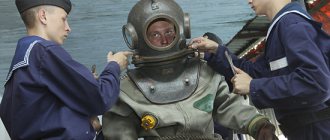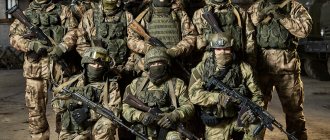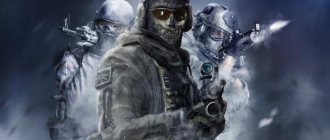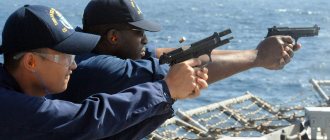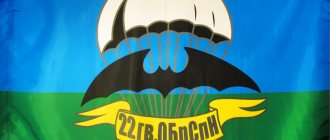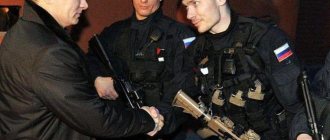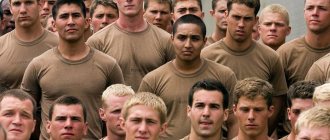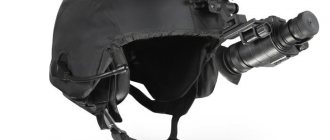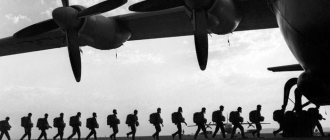Special forces are special forces combat units whose physical training is considered one of the most difficult. The fighters solve particularly difficult tasks, including the release of hostages, the capture of especially dangerous criminals and the suppression of riots. The unit recruits strong, hardy, well-trained and, most importantly, brave fighters. There is a stereotype that they should be small in stature and quite dexterous. In fact, special forces have large, pumped up bodies, and this is one of the main factors of their invincibility.
But let's not deny that training plays a huge role in the preparation of fighters. Therefore, getting closer to the ideal parameters of special forces is realistic. You just need to put in a little more effort.
View this post on Instagram
What equipment is needed for training?
It is worth saying that the entire training program can be completed at home, without resorting to purchasing expensive equipment. Basically, when performing exercises, special forces soldiers use weights, a medicine ball and a barbell. Working with kettlebells is one of the most important, since these are the exercises that build muscles and, of course, endurance.
Training with a medicine ball, on the contrary, should not cause difficulties - just stand in a pair and throw the apparatus from hand to hand. This will help increase the force of the blow and train your breathing technique.
For special forces officers, weight training is also extremely important, since in the dangerous work of soldiers it is necessary to lift weights correctly. A wounded comrade or military reserves may be in place of the barbell. Most often it is used to train the legs, because it is in the lower part of the body that most strength is collected.
Five main qualities of a special forces soldier. Caution
Intelligence has the right to select soldiers from any army unit. The very first question candidates are asked is: “Why are you joining special forces?” Applicants who do not know how to get into the GRU most often answer: “To become a Hero of Russia!” These don't qualify. Of course, they will become heroes, but posthumously. At the same time, they will take the lives of their colleagues. Recklessness is certainly needed, but only if the enemy has you pinned against the wall. Then you can take the machine gun and shout “Hurray!” run towards the enemy. Victory, from the point of view of the GRU special forces, is if you followed the order and returned alive.
When a soldier joins the special forces, from the first days they put into his head the attitude: “You are the coolest!” This is an important feature of psychological preparation. And you have to believe it! If you can’t believe it, you can forget about what GRU special forces are, how to get to serve in this department, etc. You will simply be transferred to regular infantry.
The paratrooper runs and shoots around the clock. At the same time, he is periodically beaten on the sly. But this should not be confused with hazing. Commanders deliberately turn the barracks into enemy territory. They can come up and slap you, put a noose around your neck, or mine the bed. All this is done with one goal: to force the special forces to be in a state of constant combat readiness. After six months of service, the soldier “grows” eyes on the back of his head, and he sleeps so lightly that he wakes up from one glance in his direction.
What does functional training for fighters include?
Special forces soldiers begin each day with a 10 km long run over rough terrain, in full gear with an additional weight of 50 kg. The fighters are given one hour to cover the distance. This all sounds terrifying, but the hardest test is the subsequent functional circuit training, which lasts about 40 minutes. It begins at the end of the run and a five-minute rest.
Circuit training includes the following exercises:
- Push-ups on fingers – 20 times
- Squats with jumping and clapping overhead (jumps) – 10 times
- Fist push-ups – 30 times
- Squats with jumping and clapping overhead (jumps) – 10 times
- Push-ups on fingers – 5 times
- Squats with jumping and clapping overhead (jumps) – 10 times
- Fist push-ups – 30 times
- Ab crunches - to failure
- Throwing stones
Create your own workout: exercise designer for men
The editors try: features of functional training
The exercises are performed without stopping, 5-6 circles should be completed. It would seem that this is worth stopping at, but ahead of the special forces fighters are sparring and honing hand-to-hand combat techniques.
Constant load
Candidates who know how to get into the GRU special forces understand the importance of the daily workload in the army. That is, each fighter must perform a certain number (constantly increasing) of press-ups, pull-ups, fist push-ups, etc. If you cannot do this in one training session, then you need to gain the required amount in a day. This is the expression of constant combat readiness. In addition, exercises with a belt (isometrics) according to the A. Zass system are performed throughout the day.
Text of the book “Secret Instructions of GRU Special Forces”
Chapter II Selection for GRU special forces and its training during the Soviet period
Selection of candidates for GRU special forces
In Soviet times, each military district headquarters had a Personnel Directorate, which did a lot of work on studying the personal files of officers, selecting and appointing officers. Under instructions emanating from the military district's chief of staff, each district's Personnel Directorate sought officers who met Special Forces standards. Moreover, theoretically, any young officer could be invited to join the special forces, regardless of his previous specialty in the Armed Forces.
Each officer was presented with his dossier, which was the starting point for selection. But the dossier was not the decisive factor. Upon arrival at the Personnel Department, the young officer was interviewed by several experienced officers specializing in personnel matters. During these interviews, it became clear enough whether he really stood out from the mass of hundreds of other strong-willed and physically strong people.
When the personnel officer identified such an applicant, the interview was transferred to other officers from the Intelligence Directorate, and it was they who offered the candidate a job in the special forces.
In addition, at the Faculty of Special Intelligence (created in 1968) of the Higher Airborne Command School named after. The Lenin Komsomol in Ryazan also trained professional special-purpose intelligence officers - officers for the Soviet GRU special forces. The closest attention was paid to their selection for this school. Anyone who entered this faculty was considered the best of the best.
The four years of arduous training were also four years of constant testing and selection to determine whether candidates were worthy of becoming special forces officers or not.
But after completing their training, most of them were sent to the airborne or air assault troops. Only a few were sent to the GRU special forces, but even after this, the young officer could be “exiled” to the airborne troops at any moment. Only those who showed absolute suitability for the task of special forces remained to serve in it. Requirements for the physical training of a fighter
Although in Soviet times, when selecting for the GRU special forces, the candidate was not subjected to grueling, literally inhuman tests (as is now the case in some types of special forces), nevertheless, physically, the GRU special forces soldier was initially a good athlete with great strength will, who overcame his laziness and cowardice (if he had any), who forced himself to run until he dropped every day and trained until he was completely exhausted. A special forces soldier of the Soviet GRU is a person infected with the spirit of healthy competition, who wanted to win a competition or battle more strongly than the average person, and he did not need to be driven to the point of sweat from under a stick.
But the powerfully built fighter was only one of the types of Soviet GRU special forces. There was another type, whose physique, shoulder width and the like were not particularly taken into account, although this person also had to have good physical characteristics and an equally strong character. This type could be called the “intelligentsia” of the special forces, and it included officers who were not directly placed in combat formation, but worked more with their heads than with their hands. These included translator officers with fluent knowledge of at least two foreign languages. But their contact with the soldiers was not limited to the fact that they taught foreign languages to the special forces in the classrooms. After all, the translator jumped from the plane with the unit and spent many days with the reconnaissance and sabotage group, making marches through the mountains, sand and snow. The translator was the first to receive the necessary information from the prisoners.
Translators for the Soviet army were trained at the Military Institute. And among the students of this institute there were also physically strong, with strong nerves and characters like granite. These were the ones who were invited to join the special forces.
Therefore, although the translator could have all the internal qualities of a representative of the “intelligentsia,” it was most often difficult to distinguish him from a combat soldier based on his physical characteristics.
Regarding the topic of physical training of the Soviet GRU special forces, mention should be made of combat sambo - wrestling without rules, which appeared in the Soviet Union in the 1930s.
Sambo is a form of unarmed combat with which a fighter could attack or defend against one or more opponents, including those armed with a variety of weapons. This new system, combat sambo, was partly based on judo, but without the artificial “noble” restrictions and rules. The creators of combat sambo reasoned like this: if in a real fight no one follows any rules, then why introduce them into training? Thus, combat sambo, unlike sports sambo, allowed the use of any tricks. True, during training the fighters only imitated some of the most powerful techniques (for example, chokeholds or pressure on vulnerable points) used in real combat.
Although the term “sambo” - self-defense without weapons - presupposes the absence of weapons on the part of the defender, the words “without weapons” in relation to combat sambo do not sound entirely correct, since the latter allows the use of any objects that come to hand. Therefore, we can say that combat sambo is essentially synonymous with hand-to-hand combat, where in practice everything is allowed to be used. And, for example, an army spatula in the hands of a trained fighter will be a real full-fledged weapon, and the techniques for using it are one of the elements of combat sambo. A special forces soldier can kill a person with a shovel from a distance of several meters as easily and freely as with a pistol. In the hands of a Special Forces soldier, the spade is an effective silent weapon, and every Special Forces soldier receives much more training in the use of the spade than an infantryman. The spatula can be used in hand-to-hand combat against blows with a bayonet, a knife, or against another spatula.
A fighter is taught to throw a spatula as accurately as a knife or battle axe. This weapon is well suited for throwing, being a disposable, well-balanced object whose 32cm handle acts as a good throwing lever.
Combat sambo was effective against an enemy armed with a knife, pistol, brass knuckles, metal rod or spatula. Various combat combinations were also developed. So, the fighters took turns practicing techniques: one with a large shovel, against the other with a short shovel; one with a shovel, the other with a pistol; one with a metal rod, the other with a piece of rope, etc. In Soviet times, combat sambo was a mandatory attribute in the training of every special forces soldier.
In training against a fighter who has no other weapon than a shoulder blade, an aggressive dog can be unleashed.
Each special forces soldier at one time trains in various actions against dogs. In theory, it is believed that if you simply look a dog in the eyes, then it cannot withstand the human gaze, and a person can thus stop the dog with his gaze. But in practice, it is probably better if the action of the gaze is enhanced by the action of the scapula. Special forces training for survival on the ground and in combat: training, maneuvers, exercises, competitions
The term “survival” in relation to special forces implies its ability to maintain or quickly restore its ability to perform a combat mission in accordance with its intended purpose when conducting its reconnaissance and sabotage activities. The survival, or survivability of a unit, is ensured, among other things, by its weapons, expedient organizational structure, technical equipment, high combat skills and preparation, the use of protective equipment, the protective properties of the terrain, timely dispersal and change of location.
The survival of special forces is not least due to the survivability of weapons, which in turn is ensured by the strength of its design, resistance to the effects of shock waves of high temperatures, giving products streamlined and ricocheting shapes, reducing dimensions, applying camouflage paint, and facilitating the restoration (repair) of weapons. Vitality is also called the ability of a weapon (barrel, other parts and assemblies) to withstand a certain number of shots without deteriorating its ballistic characteristics. Increasing the survivability of weapons is achieved by the initial use of high-quality materials in its manufacture and careful care during operation.
But despite the importance of weapons, they are not the only ones that ensure the success of an operation. After all, a GRU special forces soldier is, first and foremost, an intelligence officer whose task is to work on foreign territory, where survival cannot be ensured with weapons alone. This requires special knowledge and skills, and in order to operate successfully in the enemy’s camp, you must have a clear understanding of the area (country) where you will have to operate.
Moreover, this knowledge should include at least the following information:
– names of main cities;
– main religions;
– monetary units;
– characteristics of the local landscape (mountains, deserts, plateaus, etc.) and climate;
– habits of the local population.
Ideally, it would be good to understand the local language, but in any case, you need to at least know what language people speak in a given area, keeping in mind that in the same country people can speak different languages.
It rarely happens that a reconnaissance and sabotage group is dropped near an object. Usually it takes a long time to get there through very different terrain. Therefore, one of the most important aspects of the complete combat training of the Soviet GRU special forces was the training of survival techniques in difficult natural conditions.
There were many places in the USSR where people could not be found for thousands of square kilometers around. The method of such training was to parachute a small group of special forces of three or four soldiers into a completely unfamiliar place, where there are no people, no roads, nothing but blinding snow from horizon to horizon or burning sands stretching as far as the eye can see.
In this case, the drop could be carried out on the most unfavorable terrain: on thin ice, in the forest, in the mountains. In addition, the group had neither a map nor a compass. And although each fighter had a machine gun, he only had one round of ammunition. In addition, everyone had a knife and a spatula. The food supply was minimal, sometimes there was no supply at all. The group did not know how long they would have to go: a day, five days, or maybe two weeks. The soldiers could use their ammunition as they wished. They could kill a deer, elk or bear. This was enough for the whole group for a long trip. But what if wolves attack and you run out of ammunition?
To make the survival training more rigorous, the group was not given a radio transmitter and had no way of transmitting distress signals. Therefore, no matter what happened in the group, the people in it were left to their own devices until they met the first people on their way.
The fighters who passed this test were considered to have passed the test of survival in difficult conditions in a deserted area.
Since Soviet special forces had to operate in any weather conditions and on any landscape of enemy territory, GRU special forces training was carried out in different parts of the Soviet Union. Thus, the Leningrad Military District was located in harsh northern conditions, and training there was carried out in forests, swamps and tundra in an arctic climate. In the Caucasus Military District, fighters operated in high mountains, and in the Carpathian and Ural Military Districts they practiced operations in medium-height mountains. At the same time, the Carpathian Military District has a mild European climate, while in the Ural District it is sharply different: harsh, with very hot summers and very cold winters.
Each border district, as a rule, had the same natural conditions as in the territories where they would have to fight. Conditions in Karelia differ very little from those in Norway, Sweden or Finland.
To be sure that the training of GRU special forces is carried out in conditions as close as possible to those in which they will have to operate, the special forces detachments had special training centers with appropriate natural conditions. For example, in the Baltic Military District, natural conditions are very similar to those in Denmark, Belgium, the Netherlands, Northern Germany and France. The Altai Mountains are completely similar to the French Alps. If special forces were to be trained for operations in Alaska and Canada, then Siberia was an ideal choice, while for operations in Australia, special forces units would need to be trained in Kazakhstan. The special forces, which were stationed in the Arkhangelsk Military District, trained to conduct operations in the cold Arctic conditions, and the special forces soldiers located in the North Caucasus Military District learned to fight in mountainous terrain.
Special forces units had their own training centers, but any unit (or other special forces combat unit) could at any time receive an order to operate not in its training center, but in one belonging to another brigade.
In Soviet times, GRU special forces could be involved in maneuvers at various levels and with different participants. Their conditional opponents in the exercises could be troops of the Ministry of Internal Affairs, police, KGB border troops, KGB troops of the government communications network and ordinary units of the armed forces.
During the war, troops of the KGB and the Ministry of Internal Affairs were supposed to be used for actions against nationalists within the USSR. It was believed that partisan operations would inevitably be carried out in the Baltic countries, the Caucasus, and Western Ukraine. The KGB and MVD troops, which were not controlled by the Ministry of Defense, were equipped with helicopters, ships, tanks, artillery and armored vehicles, and the experience they gained from operating against special forces was extremely valuable to them. But the GRU leadership also showed enthusiasm, joining the maneuvers, for their own reasons, believing that if the GRU special forces had years of successful experience in operating against such powerful rivals as the KGB and the Ministry of Internal Affairs (which has an elite military unit No. 3111 - the Dzerzhinsky division), then he can deal with a weaker opponent faster.
It should be noted that the KGB also had its own structure, which included an organization similar to special forces, known under the term “osnaz” - a special purpose unit. The KGB used the equipment to perform a variety of tasks, often similar in many cases to those performed by the GRU special forces. But Soviet leaders believed that it was better not to have any monopolies in the field of secret war: competition produces more effective results than working according to orders.
The term "osnaz" is usually found only in secret KGB papers. In declassified documents, this term is written either in full - “special purpose”, or in abbreviation - “ON”. In cases where a long name is abbreviated, these letters “ON” are placed together with the preceding letters. For example, the UN is a “special forces force”.
After the October Revolution in 1917, descriptions of “special forces” appeared in the earliest documents of the new state. Osnaz was placed under the control of the special services, which changed their name over time: VChK (1917–1922) – GPU (1922–1923) – OGPU (1923–1934) – NKVD (1934–1943) – NKGB (1943–1946) – MGB (1946–1953) – MVD (1953–1954) – KGB (1954–1991).
Although these two words - “special” and “special” - are very close in meaning, they at the same time differ in the sense that they indicate that they belonged to different departments in Soviet times: special forces were part of the army, and osnaz - in the KGB . The fundamental difference between the special services themselves is that army special forces almost always acted against external enemies; Osnaz worked mainly on his own territory - against internal enemies. But even if the GRU special forces and the KGB were tasked with a common task for both departments, the Soviet government was not inclined to rely heavily on their cooperation due to a pronounced “instinct” for competition between them.
Thus, during the exercises this resulted in a seemingly natural “legal” confrontation: the task of the special forces is to break through to the object and destroy it, and the task of the equipment is to resist this with all their might.
During the exercises, the KGB and the Ministry of Internal Affairs (together with the military units of the Soviet army, which had to protect themselves) used a whole range of various methods of protection against the GRU special forces: from total control of radio communications to electronic sensors, from hunting aircraft equipped with the latest model equipment, to sniffing dogs.
As for the exercise scenario, it could include a long – up to ten days – raid “behind enemy lines” with the implementation of a number of combat training tasks. For example, finding a life-size rubber inflatable Pershing rocket hidden in the forest - an exact copy of the American original; locate the enemy headquarters or artillery battery, etc.
During this time, it was necessary to cover the entire route at a pace of about 8 km/h, covering 60–70 km per day (taking into account the completion of tasks). The group stopped after three or four hours for fifteen to twenty minutes. Two fighters observed the situation, and two came forward, the rest could sleep at that time.
During the exercises, it was forbidden to make fires, and the special forces prepared their food using a tablet of dry alcohol.
During the day, sometimes the group could lie down in the snow, in the bushes, in a swamp and wait it out. But at night she was usually not allowed to do this. Special forces work at night - this is their time, and if they haven’t rested during the day, they won’t have to at night.
During the day, the work became more complicated many times over: helicopters appeared in the sky; Cordons have been activated on all roads; An ambush was set up at the edge of each forest.
Each special forces group had to overcome many security lines, and at the same time, any fighter caught by the “enemy” was subject to “processing” by his osnaz, whose personnel (both according to the script and in themselves) were rude enough to knock out a fighter has any desire to be caught in the future, even during an exercise, or in a real battle.
First of all, the captured person was given a rather sensitive beating, then they were shown an archival film filmed in the concentration camps of the Second World War (these films were really much worse than what was done to them during the maneuvers).
After the “processing,” the “prisoner” should have had only one thought hammered into his head, literally and figuratively: being a prisoner is worse than dying.
Then he was released, but if he was captured again, everything would happen again. This was calculated so that in a very short time the fighter would develop a very strong negative reaction to the idea of becoming a prisoner and, of course, that death (a noble death in the understanding of the Soviet man) would be preferable.
Sometimes false objects could appear on the group’s path: missile batteries, communication centers, command posts. If the group approached them, it would fall into a trap, and it was believed that the GRU had lost.
If the group overcame all obstacles and completed the assigned task, then its personnel were noted with thanks in the order, extraordinary titles, and vacations.
To practice actions against possible enemy military targets, GRU special forces units underwent training in training centers, where the conditions and atmosphere of the area in which they were expected to operate were reproduced with high accuracy. Models of Pluto, Pershing and Lance missiles, as well as Mirage VI, Jaguar and other aircraft armed with nuclear weapons were used to designate enemy targets.
There was also artillery for firing nuclear shells, special types of vehicles used to transport missiles, warheads, etc.
During his studies, the special forces reconnaissance officer was trained in the following: demolition (a trained fighter could independently derail a train, blow up a missile silo, mine a fuel warehouse in a matter of minutes, and could make explosives even from publicly available components); skydiving; hand-to-hand combat; silent removal of sentries; recruiting agents and working with them (officers had to have good language training).
The skills that future special forces officers were given were significantly different from those received by their colleagues from other units.
Each cadet studied in depth one of four languages - English, German, French or Chinese, eventually receiving a diploma as a translator. Combat and tactical training classes were also extremely serious.
During the training, competitions were held from time to time between special forces units.
The scenario of these competitions could be, for example, this: several groups were parachuted into a certain place and had to cover a route of about 300 km. There are several control points along the route, for example, a missile, a radar, a headquarters. The passage of the route in groups was controlled by the senior command staff of the GRU intelligence department. His boss could constantly fly a helicopter along the competition route.
Unlike exercises at competitions, you could make a fire and cook dinner on it and relax next to it for a couple of hours or warm up in cold weather.
The main thing at the competition was: precise orientation, speed, determination of coordinates and communication. The rest was not so important.
The group that was the first to cover the entire route, having discovered all the objects and reporting their exact coordinates by radio, was encouraged - the personnel received leave and were awarded valuable gifts (watches, cameras, electric shavers, etc.).
